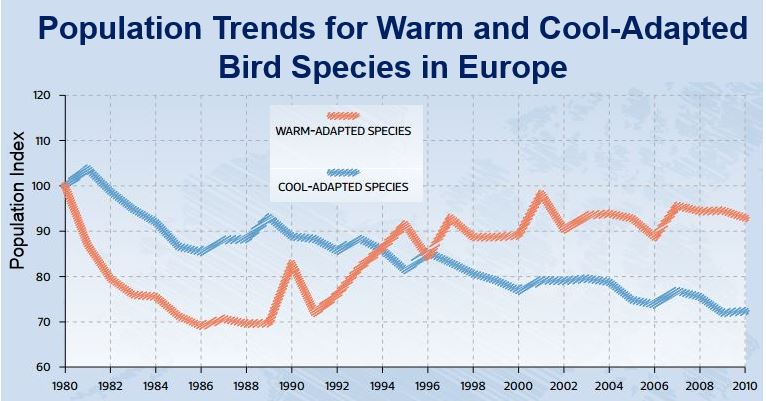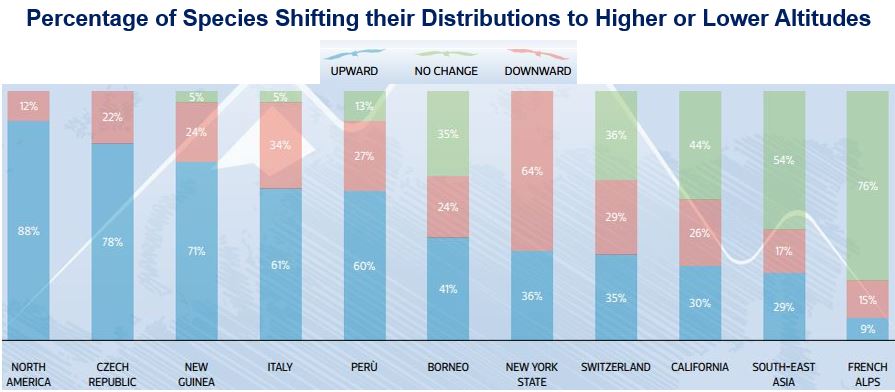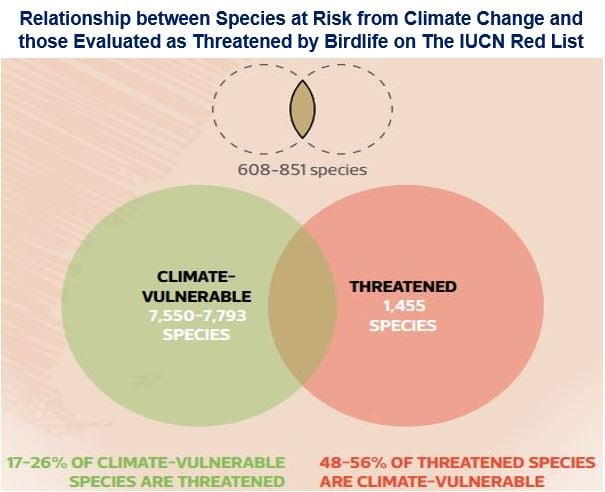Birds across the world have been migrating towards the poles or higher ground because climate change has started to warm up their habitats, says a new report issued by BirdLife International, an international partnership of conservation organisations that aims to protect birds, their habitats and global biodiversity.
The authors say that 570 bird species studied across the world have been negatively affected by climate change, while just 12% appear to have benefitted.
Co-author, Tris Allinson, said in an interview with The Guardian:
“People regard climate change as something on the horizon and about to happen but the signals from birds are that significant and profound changes are already occurring, with detrimental effects for a large proportion of the birds studied.”
 Warm-adapted species (forecast to thrive under climate change) have increased in abundance in Europe over recent decades, while cool-adapted species (whose populations are forecast to shrink) have decreased in numbers. (Image: climatechange.birdlife.org)
Warm-adapted species (forecast to thrive under climate change) have increased in abundance in Europe over recent decades, while cool-adapted species (whose populations are forecast to shrink) have decreased in numbers. (Image: climatechange.birdlife.org)
“We are seeing a consistent pattern of birds moving towards the north and south poles in their respective hemispheres, and moving to higher altitudes on mountain slopes.”
Birds are our barometers
In the Foreword of the report, Patricia Zurita, CEO of BirdLife International, and David Yarnold, CEO of the National Audobon Society, explain that over time and across cultures, birds have been sending us signals about our environment’s health.
For miners, the canary offered that most precious resource – time – during which humans had a small window to escape poisonous gases.
Canaries are no longer used by miners as an early-warning system, but birds are today our closest connection to wildlife on Earth, and they continue informing us about the health of places that both humans and birds share.
Climate change is here
Ms. Zurita and Mr. Yarnold wrote:
“Never before has their message – climate change is here and a threat to the survival of birds and people – been as clear or as urgent.”
 Many mountain bird species are shifting their ranges uphill to track suitable climate, but there is significant variation in responses, with a number of studies finding that a sizeable proportion of species have shown no change yet, or even shifted to lower elevations, probably because of changes in rainfall patterns. (Image: climatechange.birdlife.org)
Many mountain bird species are shifting their ranges uphill to track suitable climate, but there is significant variation in responses, with a number of studies finding that a sizeable proportion of species have shown no change yet, or even shifted to lower elevations, probably because of changes in rainfall patterns. (Image: climatechange.birdlife.org)
Not only is climate change affecting birds’ migration, but also their breeding cycles, which are leading to disrupted relationships with prey, predators and competitors. In several cases, these effects have reduced populations of many bird species worldwide.
As temperatures rise, threats to nature – including humans – will increase. The negative impacts of climate change on humans and birds will multiply as warming continues. While some species might benefit from warmer environments, more than twice as many species are likely to lose out.
 Worldwide, a quarter of ‘highly climatically vulnerable’ bird species are listed as threatened on the IUCN Red List, while only 1% of climatically threatened or vulnerable bird species in North America have been identified as of concern on the Red List. This suggests that climate change will increase the number of threatened species and negatively affect those already in trouble. The degree of climate change will determine the magnitude of these effects. (Image: climatechange.birdlife.org)
Worldwide, a quarter of ‘highly climatically vulnerable’ bird species are listed as threatened on the IUCN Red List, while only 1% of climatically threatened or vulnerable bird species in North America have been identified as of concern on the Red List. This suggests that climate change will increase the number of threatened species and negatively affect those already in trouble. The degree of climate change will determine the magnitude of these effects. (Image: climatechange.birdlife.org)
Key problems will get worse
The key problems are:
Reduced living spaces: most species are forecast to inhabit shrinking ranges, which will raise their risk of extinction.
Reduced populations: several species will not be able to migrate as rapidly as the climate changes, or adapt their breeding to match seasonal changes.
New communities and interactions: ecological communities will see their compositions disrupted. Changes in predators, competitors and habitats will pose considerable threats.
Current threats will intensify: as climate change accelerates, current threats will be exacerbated, such as invasive alien species, diseases, and habitat fragmentation.
Human well-being & health impacts: the lives and livelihoods of hundreds of millions of people worldwide will be increasingly threatened by climate change. The authors forecast loss of homes, food and freshwater shortage, and a greater incidence of disease.
Human responses: people will have to adapt to climate change by migrating, creating new farmland, and deploying new energy sources. “This could have substantial negative impacts for nature and people who depend on it,” the authors wrote.
Citation: “THE MESSENGERS – What birds tell us about threats from climate change and solutions for nature and people,” Stuart Butchart, Ali North, Edward Perry, Pepe Clarke, Tris Allinson, Gary Langham, Peter Adamík, Malcom Ausden, Robi Bagchi, David Baker, Mark Balman, Colin Beale, Richard Bradbury, Mark O’brien, Ariel Brunner, Ian Burfield, Cyril Caminade, Matthew Carroll, David Diaz, Kerry Emanuel, Mike Evans, Rob Field, Jaume Forcada, Morten Frederiksen, Richard Gregory, Christina Hage, Ian Henderson, Brian Huntley, Andrea Jones, Zbig Karpowicz, Simon Lloyd, Ade Long, Andrew Mckechnie, Jenny Merriman, Michela Pacifici, James Pearce-Higgins, Town Peterson, Roger Safford, Ivan Scrase, Lynsy Smithson-Stanley, Phil Stephens, Diana Stralberg, Nicolas Tubbs, Jorge Velásquez, Alke Voskamp, Ross Wanless, James Watson, Olly Watts, Steve Willis, Chad Wilsey, Blair Wolf, Melanie Heath and Peg Olsen. BirdLife International and The National Audubon Society. November 2015. ISBN NUMBER 978-0-946888-97-9.
BirdLife International Video – A Partnership of Hope
This video explains what BirdLife International is about. It is the world’s largest nature conservation partnership, comprising 121 BirdLife Partners worldwide – one per country – and growing with 13 million members and supporters, over 7,000 local conservation groups and 7,400 staff.
